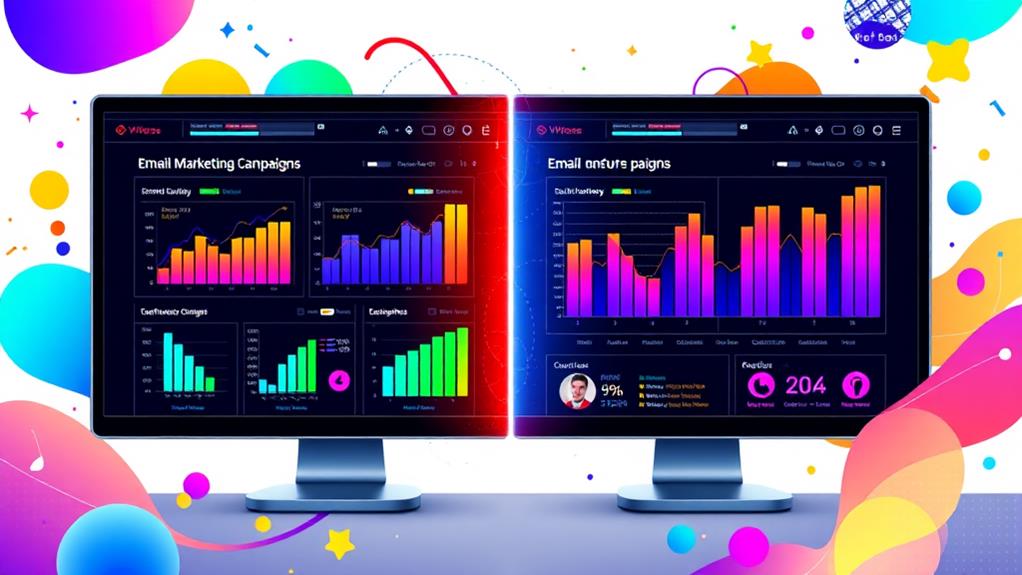To create personalized email experiences with dynamic content, integrate variable mapping to tailor messages based on subscriber data. Utilize personalized product recommendations and dynamic subject lines to boost engagement, with 65% of marketers seeing a 19% sales increase. Leverage customer data such as past behaviors and demographics for relevant, targeted emails, enhancing open rates by 29% and click rates by 41%. Implement A/B testing to optimize strategies further and include elements like location-based customization and interactive visuals for deeper connections. This dynamic approach not only meets customer expectations but also considerably improves email performance metrics, leading to more effective campaigns.
Key Takeaways
- Use subscriber data to create dynamic content, tailoring email elements for personalized messaging.
- Implement variable mapping to integrate real-time customer information into email campaigns.
- Leverage personalized product recommendations based on past behaviors to enhance engagement.
- Customize emails with dynamic subject lines reflecting personal preferences to increase open rates.
- Utilize interactive visual enhancements and location-based customization for context-specific personalization.
Understanding Dynamic Content
Understanding dynamic content is pivotal for marketers aiming to deliver personalized email experiences that resonate with individual subscribers. At its core, dynamic content refers to email elements that adapt according to subscriber data, ensuring tailored messaging that considerably enhances customer engagement and satisfaction.
This approach allows marketers to leverage variable mapping, efficiently pulling real-time customer information to craft a single optimized email campaign, rather than deploying multiple segmented emails.
A dynamic content overview reveals its multifaceted nature, offering numerous applications to meet diverse marketing needs. Dynamic content examples include personalized product recommendations that align with a recipient's previous purchases or browsing history.
Furthermore, dynamic subject lines can capture attention by reflecting personal preferences or recent interactions, while location-based offers provide relevant deals based on the subscriber's geographical area.
The adoption of dynamic content is not merely a trend but a strategic advantage. Studies indicate that 65% of email marketers prefer dynamic content for enhancing customer experiences, which translates to tangible business benefits.
Remarkably, businesses report an average sales increase of approximately 19% through dynamic content, underscoring its efficacy in boosting conversion rates and improving key marketing metrics.
Benefits of Personalization
Building on the dynamic nature of content customization, the benefits of personalization in email marketing are substantial and quantifiable. Dynamic content tailored to individual preferences greatly boosts engagement metrics, with personalized campaigns achieving 29% higher unique open rates and 41% higher click rates.
This enhanced engagement is vital in meeting evolving customer expectations, as 71% of consumers now anticipate personalized interactions from brands. By aligning content with individual preferences, businesses not only meet these expectations but also foster brand loyalty.
Moreover, the financial advantages of personalization are compelling. Dynamic emails deliver an impressive return on investment, generating an average of $36 for every $1 spent. This efficiency underscores the importance of investing in personalized content to maximize marketing budgets.
Additionally, 65% of marketing executives identify dynamic content as the most effective personalization tactic, highlighting its essential role in crafting tailored customer experiences.
The impact on sales is equally notable. Businesses that leverage dynamic content report an average 19% increase in sales, driven by customized messages and offers.
This illustrates how personalization not only builds customer satisfaction and loyalty but also directly contributes to revenue growth.
Types of Dynamic Content
Dynamic content in personalized emails encompasses a variety of elements that drive engagement and conversion, such as personalized product recommendations, which leverage purchase history to boost relevance.
Location-based email customization further enhances relevance by tailoring content to the recipient's geographical context, thereby increasing the likelihood of engagement.
Additionally, interactive visual enhancements, including personalized videos and product showcases, captivate recipients and foster active participation, resulting in a more immersive email experience.
Personalized Product Recommendations
Leveraging past purchase history and browsing behavior, personalized product recommendations stand as a pivotal type of dynamic content that enhances the customer shopping experience and fosters repeat purchases.
By utilizing sophisticated recommendation algorithms, businesses can guarantee product relevance, offering tailored suggestions that resonate with the consumer's specific needs and preferences. This approach not only enhances the shopping experience but also greatly impacts sales performance.
Research indicates that employing dynamic content for personalized recommendations can result in a 19% increase in sales, underscoring the effectiveness of customized suggestions in driving revenue growth.
Analyzing consumer behavior allows companies to deliver targeted product recommendations in real-time, effectively engaging the audience by fostering a sense of connection and personalization.
This strategy has been shown to improve both engagement and click-through rates. Reports highlight a remarkable 41% increase in click-through rates when dynamic content is utilized, demonstrating its potential to boost customer interaction and conversion rates.
Moreover, dynamic content enables marketers to tailor recommendations using demographic data.
Location-Based Email Customization
Tapping into the power of location-based email customization, marketers can greatly enhance the relevance and engagement of their communications by tailoring content according to a recipient's geographical area. This approach leverages location relevance to increase the effectiveness of email campaigns considerably.
By incorporating cultural nuances and geographic data, businesses can personalize their offerings to align with local events or preferences, thereby boosting open rates and engagement.
Dynamic content adapts email timing to the recipient's time zone, guaranteeing messages arrive when users are most active, thereby optimizing interaction. Additionally, marketers can incorporate current weather conditions into their strategies, promoting products or services that align with the recipient's local climate.
This level of personalization not only captures attention but also influences purchasing behavior, driving conversion rates upwards.
Businesses implementing location-specific promotions report higher engagement, as emails resonate on a personal level, fostering a stronger connection with the audience.
The granularity of tailoring content to location allows brands to meet local expectations and preferences, enhancing overall campaign performance.
Leveraging these strategies guarantees that email communications remain relevant and engaging, ultimately leading to increased customer satisfaction and loyalty.
Interactive Visual Enhancements
With the advent of interactive visual enhancements, email marketing has evolved into a more engaging and personalized experience.
These enhancements leverage visual storytelling to capture attention and foster emotional engagement, transforming static emails into dynamic, responsive experiences.
Here are four impactful ways to implement interactive visual enhancements in email campaigns:
1. Personalized Product Images: Tailor images to fit individual recipient profiles, showcasing products that align with their preferences.
This level of personalization increases relevance and engagement, making recipients more likely to respond positively.
2. Dynamic Imagery: Use images that reflect the audience's interests and demographics.
By evoking emotional responses, these visuals can greatly boost the overall email experience, creating a deeper connection with recipients.
3. Video Content: Incorporate videos to enhance engagement rates, as emails featuring videos can increase click-through rates by up to 300%.
Videos are powerful tools for visual storytelling, making content more compelling and memorable.
4. Location-Based Visuals: Employ visuals that adapt to the recipient's location, such as weather-specific product recommendations.
This strategy enhances personalization by making content relevant to the recipient's current context, thereby driving higher engagement.
Interactive elements like clickable images and sliders further encourage recipient participation, leading to increased conversion rates.
Leveraging Customer Data
Leveraging customer data is pivotal for implementing data-driven personalization techniques that enhance email marketing efforts.
By utilizing insights from purchase history and browsing behavior, marketers can craft highly relevant product recommendations, while demographic data allows for customized visuals and messaging that resonate with specific audiences.
Additionally, analyzing behavioral insights such as abandoned carts and recent purchases enables real-time content updates and targeted follow-ups, greatly boosting engagement and conversion rates.
Data-Driven Personalization Techniques
Harnessing the power of customer data has become a cornerstone for businesses aiming to enhance their email marketing strategies through data-driven personalization techniques.
By employing customer segmentation and data analysis, businesses can reveal the potential of creating deeply personalized email experiences. Understanding the nuances of customer data, such as purchase history and browsing behavior, can lead to tailored product recommendations that resonate with individual preferences, boosting engagement and increasing conversion rates by up to 19%.
Here are four effective techniques for leveraging customer data:
- Tailored Product Recommendations: Analyze purchase history and browsing behavior to deliver targeted recommendations, enhancing customer engagement and conversion rates.
- Demographic Customization: Utilize demographic data, such as age and gender, to personalize email visuals and messaging. This approach can improve click rates by 41% and foster deeper connections with subscribers.
- Segmented Targeting: Segment audiences based on purchase history and engagement levels to deliver targeted offers. This strategy increases the likelihood of engagement and fosters brand loyalty.
- A/B Testing: Implement A/B testing on different dynamic content strategies to identify the most effective personalization techniques, ensuring continuous optimization and improved email performance metrics.
Behavioral Insights Utilization
Analyzing behavioral insights has become an indispensable tool in crafting highly personalized email marketing campaigns. By meticulously tracking customer interactions, such as website visits and email engagement, marketers can employ behavioral segmentation to tailor content to specific user actions and preferences. This approach guarantees that each email aligns closely with the customer's journey, enhancing relevancy and engagement.
For instance, analyzing past purchase behaviors allows businesses to recommend products that resonate with individual preferences, thereby increasing conversion rates and boosting the average order value.
Additionally, leveraging real-time behavioral insights, such as abandoned cart data, enables marketers to send timely and targeted reminders. These reminders often highlight specific products, greatly improving the recovery rate of lost sales.
Employing A/B testing on various behavioral triggers further refines email strategies. Through such testing, marketers can discern which messaging and offers most effectively resonate with their audience, optimizing the overall email campaign performance.
Ultimately, the utilization of behavioral insights facilitates timely and relevant communications, increasing customer satisfaction and fostering deeper brand loyalty. This data-driven approach not only personalizes the email experience but also positions businesses to meet their customers' evolving needs more effectively.
Crafting Personalized Messages
Crafting personalized messages in email marketing involves a strategic blend of creativity and data-driven insights to resonate with each recipient on a personal level. By carefully calibrating the message tone and incorporating emotional appeal, marketers can forge stronger connections with recipients.
Personalized greetings, using recipients' names, enhance engagement by making emails feel uniquely tailored. Dynamic subject lines that align with recipient interests or behaviors markedly increase open rates, boasting a 29% higher unique open rate compared to generic counterparts.
To streamline your personalization strategy, consider these key tactics:
- Customized Offers: Tailor offers to match recipients' preferences and purchase history, leading to a reported 19% increase in sales. This approach guarantees that content is not only relevant but also compelling enough to drive conversions.
- Real-Time Alerts: Utilize real-time updates, such as reminders for abandoned carts, to keep recipients informed and engaged. These alerts prompt immediate action, capitalizing on recent interactions.
- A/B Testing: Regularly conduct A/B testing on personalized messages to determine the most effective content strategies. This helps in optimizing click-through rates and overall engagement.
- Segmented Lists: Create segmented email lists based on demographics and behaviors to deliver more targeted content, enhancing the overall personalization experience.
Strategies for Engagement
Effective strategies for engagement in email marketing leverage a combination of personalized content and data-driven tactics to meet consumer expectations and enhance interactions. To achieve this, email segmentation techniques and audience targeting strategies are essential.
Personalized greetings and dynamic subject lines, incorporating recipient names and interests, are vital; statistics show that 71% of consumers expect such tailored interactions from brands. Behavioral data plays a significant role in triggering customized offers and recommendations based on past purchases, enhancing click-through rates by up to 41%.
Dynamic imagery, informed by demographic data such as age and gender, further refines targeting, fostering deeper engagement by appealing to specific preferences and emotions. Additionally, integrating countdown timers for limited-time offers can effectively create urgency, encouraging immediate action and boosting conversion rates.
Continuous testing and optimization through A/B testing help marketers refine these strategies. By analyzing engagement metrics, they can identify the most effective dynamic content approaches, ensuring that email campaigns remain targeted and impactful.
Implementing such data-driven tactics not only increases engagement but also strengthens brand-consumer relationships, ultimately leading to more successful email marketing outcomes.
Measuring Success
Evaluating the success of dynamic email content is essential for optimizing marketing strategies and achieving desired outcomes. By focusing on specific success metrics, marketers can gain valuable insights into the effectiveness of their personalized email campaigns. Engaging in a thorough engagement analysis helps identify areas for improvement and capitalize on high-performing strategies.
Here are four key metrics to take into account:
- Open Rates: Personalized emails have been shown to achieve a 29% higher unique open rate than their non-personalized counterparts. Monitoring this metric provides a clear indication of how well dynamic content resonates with the audience.
- Click-Through Rates (CTR): With a 41% higher click rate for personalized messages, analyzing CTR helps marketers understand which elements of their emails drive interaction and engagement.
- Conversion Rates: The ultimate goal is to convert engagement into action. Measuring conversion rates offers a direct view of how dynamic content influences subscriber behavior and contributes to revenue growth.
- A/B Testing Results: Employing A/B testing allows for a comparative engagement analysis of different dynamic content strategies, enabling marketers to refine their approach based on subscriber preferences and behaviors.
These metrics collectively guide data-driven decisions, enhancing the personalization and effectiveness of email campaigns.
Continuous Optimization
To sustain the effectiveness of dynamic email content, continuous optimization is essential. This process involves deploying A/B testing for various elements, such as subject lines and calls-to-action, which can greatly impact engagement and conversion rates. By regularly auditing content and analyzing performance metrics, marketers can fine-tune their strategies to better resonate with their audience. This approach not only identifies successful elements but also highlights areas needing improvement.
| Optimization Element | Purpose |
|---|---|
| A/B Testing | Identify high-impact variations |
| Content Audits | Refine strategies through performance metrics |
| Recipient Feedback | Tailor content to evolving preferences |
| KPI Monitoring | Data-driven enhancements over time |
Gathering recipient feedback through surveys or analyzing engagement patterns is invaluable in guaranteeing dynamic content aligns with customer preferences and behaviors. Insights from past campaigns are vital, often resulting in an average sales increase of 19% through customized messaging. Consistent monitoring of key performance indicators, such as open and click-through rates, guarantees data-driven adjustments that enhance email effectiveness.
Frequently Asked Questions
How to Use Dynamic Content in Email Marketing?
To effectively use dynamic content in email marketing, employ personalization strategies and dynamic content tools to tailor messages. Leverage subscriber data, behavioral insights, and testing to enhance engagement, optimize performance, and drive targeted, data-driven campaign success.
How to Create a Dynamic Email?
To create a dynamic email, integrate dynamic fields based on user preferences, leveraging data from signup forms. Utilize platforms like Mailchimp for adaptable templates, and employ A/B testing to refine engagement through targeted personalization strategies.
Can You Explain How Dynamic Content or Personalization Is Used Within Segmented Email Campaigns?
Dynamic content in segmented email campaigns leverages user behavior and target audience data to tailor messaging, enhance engagement, and optimize performance. Personalization through dynamic elements fosters relevance, yielding significant improvements in open and click rates.
How Do I Add Dynamic Content in an Email Template?
To add dynamic content in an email template, integrate dynamic fields to personalize data and utilize content blocks for tailored messaging. This approach enhances engagement by delivering targeted experiences based on specific criteria and recipient interactions.
Conclusion
The integration of dynamic content in email marketing facilitates the creation of personalized experiences that enhance engagement and drive conversions. By leveraging customer data, marketers can craft tailored messages that resonate with individual preferences, thereby increasing the effectiveness of communication strategies. Employing various types of dynamic content and continuously optimizing these efforts guarantees sustained relevance and impact. Measuring success through pertinent metrics allows for data-driven adjustments, ultimately fostering more meaningful interactions and long-term customer loyalty.




